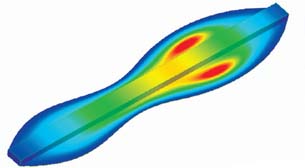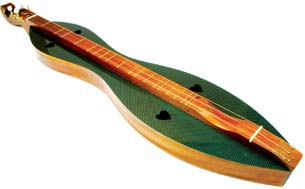May 1, 2011
By Pamela J. Waterman
Fiber-reinforced technology is seeing extensive use for its low weight-to-strength ratios—as well as other benefits. But working with composites is rarely a 1-2-3 process. If ever there was a need for close cooperation among designers, structural analysts and manufacturing engineers, this is the time, and optimization plays a key role across the board. With dozens of software packages addressing these challenges, DE takes a look at what’s new, what’s critical and what challenges remain.
|
Composites: Why now?
The term composite covers material compositions ranging from glass-filled liquid resins to “fabric” sheets with embedded carbon fibers. (See “The Life of Composite Materials,” DE May 2007.) Just that difference helps explain the variety of software packages targeted to the field.
Depending on the exact formulation, composite materials display such positive attributes as easy formability, strength with light weight, excellent long-term weathering and resistance to corrosion and chemicals. These advantages, in turn, may make it easier to integrate multiple parts. Plus, properties such as good thermal stability and high thermal conductivity are increasingly useful in special applications.
However, achieving these desirable properties is a challenge at every step—from initial design to hand-done or automated part creation.
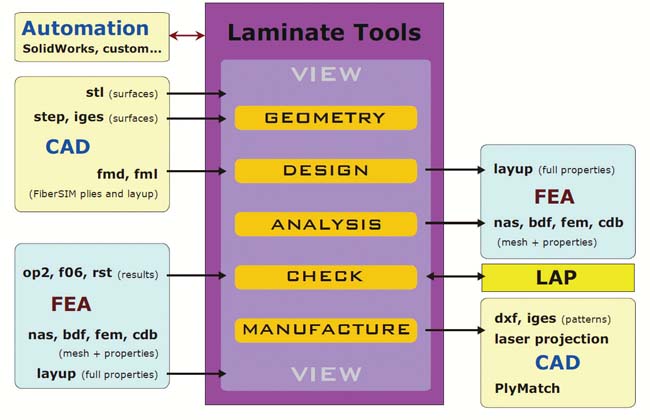 This typical Anaglyph Laminate Tools composite analysis flow chart shows how Laminate Tools interacts with other engineering software applications. Image courtesy of Anaglyph. |
“The material and manufacturing costs of composites are high compared to ‘traditional materials,’” explains Markku Palantera, general manager at Componeering. “Therefore, the superior performance of the end product must be achieved by careful design, which eventually involves software.”
Defining Your Role
Componeering, which markets ESAComp, is one of a number of companies focused on composites-specific software. How these firms can help you depends partly on your specific project, partly on your existing CAD and CAE software, and partly just on your preferred approach to working with these materials.
Not surprisingly, opinions run strong and deep in this corner of the design world. Dr. John Klintworth, Simulayt’s founder and managing director, points out the major source for differences in perspective is whether you operate in a CAD environment or an analysis environment.
“Any conventional ]finite element analysis, or FEA] package cannot do design and manufacture, and cannot even create a decent composites model,” he continues. “What you need is a dedicated tool in the design or analysis environment that can model the composites structure.”
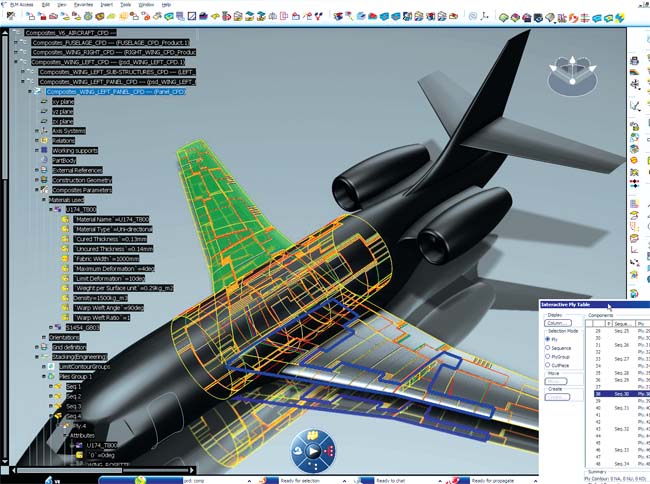 The Interactive Ply Table in the Grid Design in Version 6 of CATIA Composites from Dassault Systèmes. Image courtesy of Dassault Systèmes. |
Dr. Olivier Guillermin, VISTAGY director of product and market strategy, echoes these thoughts, saying that while both sides may need to simulate draping of a composite, the intent is different.
“Design works with a very detailed, complete, producible design, while analysis works with a simplified model made for analyzing such behavior as delamination, buckling and noise or vibration,” he says.
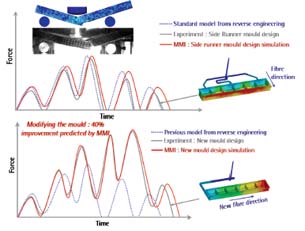 This illustrates the macroscopic response dependency on the process parameters using DIGIMAT to LS-DYNA. MMI denotes the DIGIMAT to Moldflow and LS-DYNA solution process. Image courtesy of e-Xstream Engineering. |
Whichever your angle, your part should also be evaluated for producibility—meaning you may want to tap the power of micromechanical analysis found in such packages as Alpha STAR Corp.’s GENOA, ESI Group’s SYSPLY, e-Xstream’s DIGIMAT, Firehole Composites’ Helius:CompositePro or LUSAS Plus Composite.
Identifying the complexity of your application will also help guide you to an appropriate choice. (See “Composites Analysis: Making New Choices,” DE March 2009, for detailed software feature checklists.)
Digging into Details
No two packages offer the same features, so here we highlight 10 possibilities to give you a sense of the breadth in today’s tools. For more options grouped by general product function, see “A Spectrum of Composite Software for Design, Analysis, Manufacture and Optimization,” page 24.
e-Xstream Engineering’s material modeling platform, DIGIMAT, increases the predictivity and accuracy of a user’s current design and analysis tools for reinforced plastics and a range of composite materials. DIGIMAT’s coupling of the material description with commercial CAE codes (e.g. non-linear FEA solvers, injection molding software, etc.) allows precise modeling of the composite structure’s behavior, accounting for fiber orientation and determining its effects at the micro-structure level.
When dealing with molded parts made with reinforced plastics, Keith Parmentier, business development manager at e-Xstream Engineering, notes, “Designers need to be able to make accurate predictions and optimal choices regarding issues such as product performance, weight reduction, material costs, etc., in order to select the right mold designs and materials. DIGIMAT can, for example, indicate the need to modify a mold design to optimize the dispersion or orientation of the reinforcing fibers, resulting in higher final product performances.”
VISTAGY’s FiberSIM software suite bridges the design-manufacturing gap by incorporating non-geometric data that CAD systems do not. It can work with ply-based, zone-based or structure-based designs, and has versions targeted to NX, ANSYS, Pro/ENGINEER (now Creo Elements/Pro) and CATIA. Recently, VISTAGY and ANSYS announced an integrated version of FiberSIM 2010 with ANSYS 13.0 Composite PrepPost software to help close the loop between composites design and analysis. The integrated, bi-directional solution (an add-in for both packages) will help designers and stress analysts efficiently exchange data, eliminating the disconnect between part certification and manufacturing—a huge issue, especially for aeronautic applications.
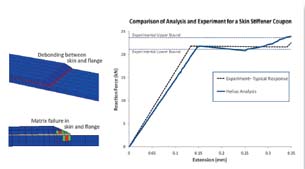 Debonding and matrix failure in a laminated composite, as analyzed with Firehole Composites software. Red in the upper image shows failure of cohesive elements, using the new cohesive functionality in Helius:MCT v4.0, indicating debonding between skin and flange. In the lower image, green indicates matrix failure and red indicates fiber failure. The plot shows correlation with physical testing. Image courtesy of Firehole Composites. |
Componeering has improved ESAComp from its European Space Agency origins. It includes a material database, options for performing material trade-off studies, and laminate analysis and lay-up design tools. In comparison to a generalized FE program, it offers capabilities for a quick, initial structural analysis, as well as a more advanced analysis that accounts for statistical variations in material properties, layer angles and loads. ESAComp helps users find the most suitable structural concept (such as solid laminate, sandwich or stiffened panel) and includes tools for specialized applications such as pressure vessels.
Another well-known company in the composites design world is Firehole Composites, offering four packages including Helius:CompositePro (originally developed by Peak Composites).
“Prospector:Composites and Helius:CompositePro are really front-end tools designed to quickly and easily help engineers of any level of expertise in the early stages of composite design and analysis,” explains Angie Shrader, the company’s engineering manager. “Helius:MCT and Helius:Fatigue provide enhanced composite capability to FEA.”
She adds the latter have been particularly designed for both accuracy and practicality, combining a multi-scale failure analysis approach with computational methods targeted to composites.
Once you have a design, how can you make it better? The HyperSizer family of products from Collier Research Corp. tackles the job of optimizing the fine details of fabricating composite parts—identifying, for example, which plys should span the length of a part, which could be cut to save weight, and just how to shape the resulting boundaries. As company president Craig Collier explains, the three primary products in this family—HyperSizer Material Manager, Basic and Pro—show you the most efficient and manufacturable approach to a design. This helps determine the complete specification, including just how to interleave the plys—a level of detail that saves time, assures repeatability and assists manufacturers’ compliance with test regulations.
Dassault Systèmes’ CATIA Composites Workbench, with various releases, continues to be a widespread tool in many composites design applications, so it’s no surprise that multiple paths exist to its use. Rani Richardson, CATIA Composites product specialist, observes that collaboration among designers, analysts and manufacturers is critical, particularly because an analyst is making updates while the designer is still working on the part, for example.
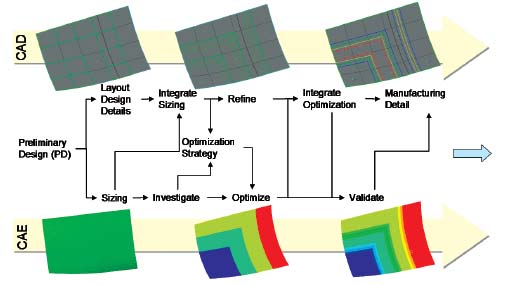 Seamless workflows between VISTAGY’s FiberSIM software and MSC.Software’s SimXpert move a design from preliminary sizing to final part validation. The parallel process helps designers and analysts optimize the part based on weight, performance, design specifications, and manufacturing costs. Image courtesy of VISTAGY. |
“All of those models have to be in sync, and not all the tools are made to do that—and none to the capacity of CATIA Composites,” she says, noting that because SIMULIA is a Dassault Systèmes product, it is therefore well integrated with the company’s brands. “We also use Simulayt’s Composite Link to talk to ANSYS, Patran/Nastran and Abaqus/CAE—in some cases, in a bidirectional loop.”
This coupling helps provide a seamless, integrated approach for analysis, and includes the manufacturing processes as well, Richardson says.
| Composites Symposium at NAFEMS World Congress A great time and place to hear the latest on composites design, analysis and manufacturing is at this month’s NAFEMS World Congress 2011, to be held in Boston, May 23-26. Two sessions will focus on varied aspects of this field and give you a chance to talk shop with consultants from Firehole Composites, SAMTECH and e-Xstream Engineering. Learn more at NAFEMS.org/congress. |
NEi Software’s NEi Nastran has years of development behind it for handling many aspects of defining fiber orientation directly. It also brings in advanced ply-based model building as needed through Simulayt’s Composites Modeler for Femap and Composites Modeler for SolidWorks. One of the company’s users, consultant Joseph Kummer of ALLRed & Associates, says that NEi has done an excellent job including composite materials in its simulations, not only with improved models but with a better user interface, too.
“Now I don’t have to spend as much time setting up a problem,” he says. “They’ve made it easier to set up assemblies where there are contacts with some parts glued and others pressing up, and the newer models give me high confidence consistent with validations.”
Anaglyph is the developer of several relevant packages, including the extensive Laminate Tools. This stand-alone application is comprised of six modules: View, Geometry, Design, Analysis, Check and Manufacture. It provides an integrated solution dealing with all aspects of the process: from geometry import through design (draping simulation) and analysis of properties specific to composites, to producing the export plybook with flat patterns of the plies to be manufactured. All partners involved in this process can exchange data.
In addition, as a pre- and post-processor, Laminate Tools interfaces with standard CAD and FEA applications to produce composite-specific results. It also offers an embedded interface with Solidworks, Nastran and ANSYS, as well as with Anaglyph’s hand layup ply-placement software, PlyMatch.
STRAND7 is a general-purpose FEA package with an optional laminated composite module tightly integrated with the rest of the system. Users can easily combine traditional plate/shell composite elements with 1D prismatic beam elements, as well as 3D brick elements. The company notes that its price/performance ratio in the FEA software arena is particularly appealing for small organizations because it supports the full spectrum of design concept evaluation, detailed analysis and the production of layup schedules.
| Carbon Fiber Manufacturing Plant to Supply BMW It all starts with the fibers, and we can’t seem to get enough. BMW is building a facility in Moses Lake, WA, which may soon become the world’s largest such plant. BMW and SGL Group, a carbon manufacturing company, are creating this source to supply BMW’s Megacity high-tech electric car, planned for launch before 2015. See goo.gl/YIXum for more information. |
Simulayt’s solutions for the composites field have been in continuous development for 20 years. As the developer of Layup Technology, which incorporates advanced fiber simulation and ply modeling capabilities, the company is positioned to offer software tools running in both CAD and CAE systems. The products are deeply embedded in CATIA V5, Abaqus/CAE, SolidWorks and Femap, and allow users to define plys on individual finite elements, reflecting the actual manufacturing process.
As an example of its power, you could define a part with 200 plies, then with the push of a button automatically generate 2,000 laminate properties—a task impossible to do by hand.
Multi-layered Challenges
A metal is a metal, but composites are a whole ’nother ballgame. As Firehole Composites’ Shrader puts it, “The biggest software challenge in working with composites is simultaneously capturing all of the physics involved, while also maintaining reasonable computational time and resources.”
You definitely need specialized tools to achieve this balance. The good news is, as users realize there’s a good return on investment in specifying these materials, the software developers are right there, expanding their support.
A Spectrum of Composite Software for Design, Analysis, Manufacture and Optimization Following is a sampling of composite software packages, categorized from modeling the simplest structures to performing general and complex FE analyses. Crossover among categories also exists.
|
More Info:
ADINA R&D
Alpha STAR
ALLRed & Associates
Altair Engineering
Anaglyph
ANSYS
Autodesk
Collier Research Corp.
Componeering
Cranes Software
Dassault Systèmes
ESI Group
e-Xstream Engineering
Firehole Composites
Lindell
LUSAS
MSC.Software
NEi Software
PTC
SAMTECH
Siemens PLM Software
Simulayt
SIMULIA
Strand7
Vanderplaats R&D
VISTAGY
Contributing Editor Pamela Waterman, DE’s simulation expert, is an electrical engineer and freelance technical writer based in Arizona. You can send her e-mail to [email protected].
Subscribe to our FREE magazine, FREE email newsletters or both!
About the Author
Pamela Waterman worked as Digital Engineering’s contributing editor for two decades. Contact her via .(JavaScript must be enabled to view this email address).
Follow DE






